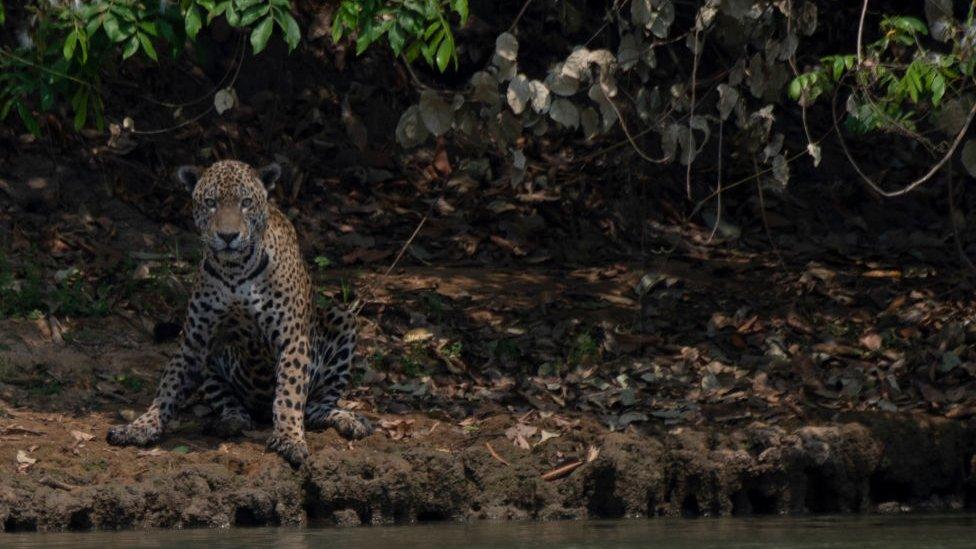Hydroelectric dams linked to tiger and jaguar losses
- Published

Tigers in Sumatra are a critically endangered sub-species, which face additional threats from two hydropower dams planned within their habitat
The global expansion of hydroelectric dams has had a destructive impact on the habitats of tigers and jaguars, according to a new study.
Researchers found that dam construction, particularly in Asia, has affected more than one-fifth of the world's remaining tigers.
In some local forest areas, the dams are said to have precipitated tiger extinction.
Jaguars face a growing threat with dams on their ranges expected to quadruple.
The modern world has not been kind to tigers.
Despite their iconic and fearsome reputation, tigers have disappeared from over 90% of their original range over the past century.
While their numbers have improved in recent years, they are still classified by the IUCN as an endangered species, external, with around 3,500 in total.

A jaguar at rest
It's a similar story for jaguars.
The distribution of these lithe predators, which range between the US south-west and Argentina, has halved.
This new study suggests that global efforts to develop hydropower for energy have had a destructive impact on the habitats occupied by these species.
The researchers identified over a thousand existing dams that intersect with the ranges of tigers and jaguars.
They painstakingly worked out the amount of forest areas impacted by the construction and concluded that over 13,000 square kilometres of tiger habitat had been flooded to create reservoirs for the dams.

Roads often help fragment forest areas where tigers live
This is likely to have had a significant impact on tiger numbers.
"More than one in five tigers have presumably been affected by habitat flooding as induced by the construction of dams," said co-author Ana Filipa Palmeirim, from the University of Porto.
"As such, that habitat loss is expected to contribute to the decline in the overall tiger population size."
"Without these reservoirs, the tiger population today could be 20% larger," said co-author Dr Luke Gibson, from the Southern University of Science and Technology, in Shenzhen, China.
"And that goes a long way towards any goal to increase or even double the global tiger population, as many policymakers have recently set their sights on."
In some local areas, the building of dams has likely seen tiger extinctions.

Extinction bit-by-bit
The development of a hydropower reservoir needs roads and the construction often breaks a formerly unified forest into smaller pieces.

Cheow Lan lake in Thailand has seen tigers disappear after a dam was built to create a reservoir
In the 1980s, the construction of a dam and reservoir at Cheow Lan in Thailand flooded around 165 square kilometres of forest, breaking it up into more than 100 islands of varying sizes.
"Shortly after the reservoir flooded, tigers disappeared from this landscape," said Dr Gibson.
"So the creation of a large reservoir smack in the middle of the landscape split that forest into smaller patches, and because of that, often, those tigers will not be able to survive in that fragmented forest landscape."

For jaguars, the building of dams is more of a future than a current threat.
While over 25,000 square kilometres of their ranges have been lost to existing construction, the number of dams in their habitat areas is set to quadruple.

A jaguar on the banks of a river in Brazil
Many of these will be located in the Amazon, with Brazil planning on building over 300 dams within jaguar areas.
It raises the question for the authors of whether the benefits of these future developments outweigh the environmental costs.
"This should be a major warning call for conservation practitioners," said Prof Neil Carter from the University of Michigan, who was not involved in the research.
"The study underscores the importance of the conservation community working early and collaboratively with land planners, energy developers, and engineers to eliminate or reduce the impacts of dams on terrestrial species before it is too late."
"Moreover, it underscores the importance of transparency on dam building projects including open data on project footprint, reservoir size, and megawatt capacity, to enable comprehensive impact assessments and mitigation."
The study has been published, external in the journal Communications Biology.
Follow Matt on Twitter., external.